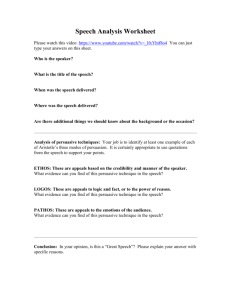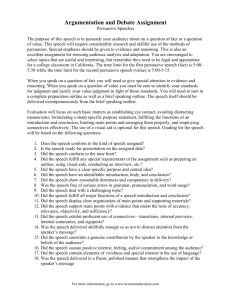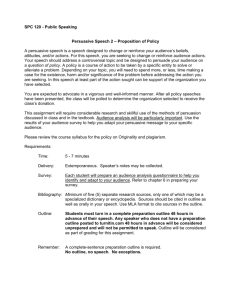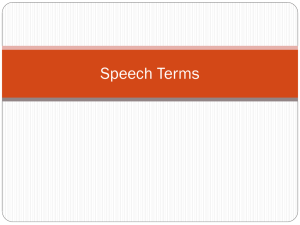Rubric
advertisement
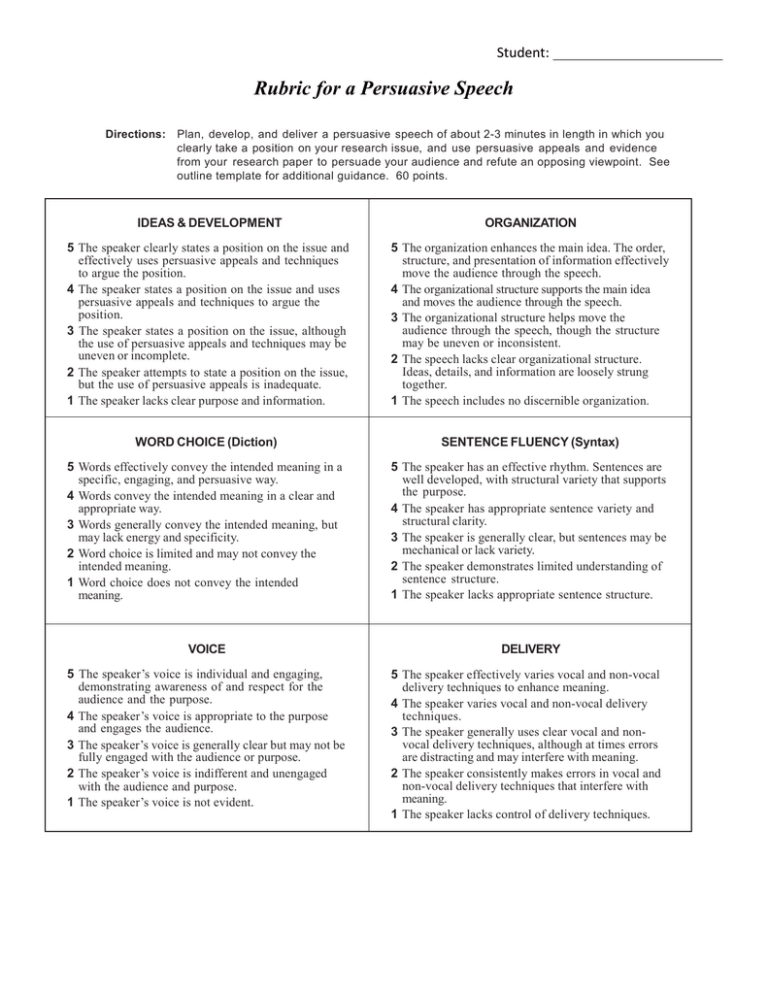
Student: Rubric for a Persuasive Speech Directions: Plan, develop, and deliver a persuasive speech of about 2-3 minutes in length in which you clearly take a position on your research issue, and use persuasive appeals and evidence from your research paper to persuade your audience and refute an opposing viewpoint. See outline template for additional guidance. 60 points. IDEAS & DEVELOPMENT ORGANIZATION 5 The speaker clearly states a position on the issue and effectively uses persuasive appeals and techniques to argue the position. 4 The speaker states a position on the issue and uses persuasive appeals and techniques to argue the position. 3 The speaker states a position on the issue, although the use of persuasive appeals and techniques may be uneven or incomplete. 2 The speaker attempts to state a position on the issue, but the use of persuasive appeals is inadequate. 1 The speaker lacks clear purpose and information. 5 The organization enhances the main idea. The order, structure, and presentation of information effectively move the audience through the speech. 4 The organizational structure supports the main idea and moves the audience through the speech. 3 The organizational structure helps move the audience through the speech, though the structure may be uneven or inconsistent. 2 The speech lacks clear organizational structure. Ideas, details, and information are loosely strung together. 1 The speech includes no discernible organization. WORD CHOICE (Diction) SENTENCE FLUENCY (Syntax) 5 Words effectively convey the intended meaning in a specific, engaging, and persuasive way. 4 Words convey the intended meaning in a clear and appropriate way. 3 Words generally convey the intended meaning, but may lack energy and specificity. 2 Word choice is limited and may not convey the intended meaning. 1 Word choice does not convey the intended meaning. 5 The speaker has an effective rhythm. Sentences are well developed, with structural variety that supports the purpose. 4 The speaker has appropriate sentence variety and structural clarity. 3 The speaker is generally clear, but sentences may be mechanical or lack variety. 2 The speaker demonstrates limited understanding of sentence structure. 1 The speaker lacks appropriate sentence structure. VOICE DELIVERY 5 The speaker’s voice is individual and engaging, demonstrating awareness of and respect for the audience and the purpose. 4 The speaker’s voice is appropriate to the purpose and engages the audience. 3 The speaker’s voice is generally clear but may not be fully engaged with the audience or purpose. 2 The speaker’s voice is indifferent and unengaged with the audience and purpose. 1 The speaker’s voice is not evident. 5 The speaker effectively varies vocal and non-vocal delivery techniques to enhance meaning. 4 The speaker varies vocal and non-vocal delivery techniques. 3 The speaker generally uses clear vocal and nonvocal delivery techniques, although at times errors are distracting and may interfere with meaning. 2 The speaker consistently makes errors in vocal and non-vocal delivery techniques that interfere with meaning. 1 The speaker lacks control of delivery techniques. Outlining the Persuasive Speech Directions: Use information presented in your research paper to develop a persuasive speech in which you argue a clear position based on your research. Since you will have limited time to speak, be sure to focus only on those elements from your research that are essential and most likely to be interesting and persuasive to your audience. You should plan (and practice) for your speech to take around 2-3 minutes. Include at least one logos, ethos, and pathos rhetorical appeal in your speech. Complete this outline, and turn it in with your speech (bullets are encouraged). You will turn in the outline with the speech rubric, but the outline will only be checked for completion, not for content. You cannot, however, give your speech and receive a grade without a completed outline. 1. Introduction Begin with an attention-getting quote, statistic, or provocative question drawn from the research paper 2. Background Information Provide a brief overview of the issue—why it was and continues to be a controversial issue—and be sure to include a clear statement of your position. 3. Argument for Your Position Provide three supports for your position, strategically organizing the most effective evidence: 4. Acknowledgment and Refutation of Opposing Point of View Briefly acknowledge a meaningful opposing argument, but point out why it is unpersuasive or incomplete. 5. Conclusion Briefly restate the best point(s) for your position, and urge the audience to adopt your position (perhaps by direct address) 6. Identify Rhetorical Appeals Briefly identify three points in your speech in which you used logos, ethos, & pathos respectively.

